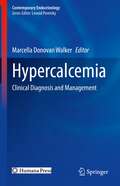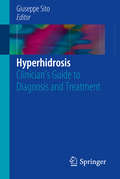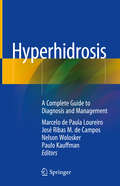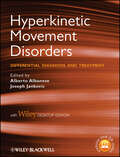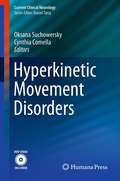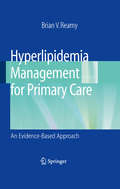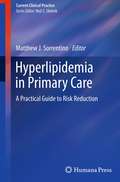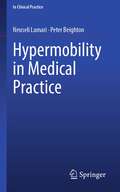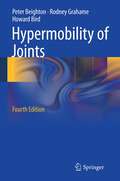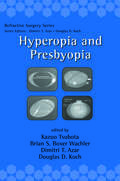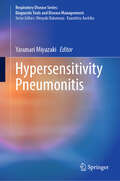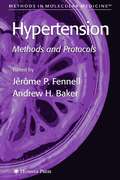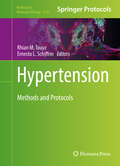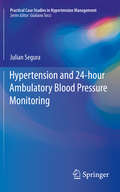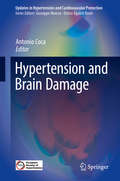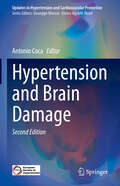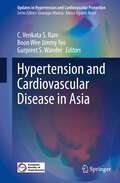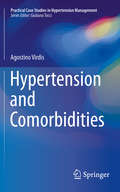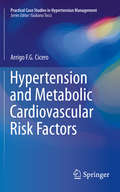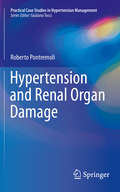- Table View
- List View
Hypercalcemia: Clinical Diagnosis and Management (Contemporary Endocrinology)
by Marcella Donovan WalkerWhile there are some books that include discussions of individual causes of hypercalcemia, there are none that provide basic guidance on the approach, diagnosis and treatment of hypercalcemia, while also offering an in-depth, detailed, state-of-the-art review of the individual causes by world-renowned experts in the field. Topics discussed include pathophysiology, differing diagnostic strategies for both the pediatric and adult patient, the various forms and causes of hypercalcemia as well as current treatment regimens and algorithms. Selected chapters are enhanced with illustrative cases, thereby complementing theoretical matter with real-world applications to the practice of medicine, and tables and figures allow the reader to solidify concepts in an easily digestible format. By integrating an evidence- and guideline-based framework along with an up-to-date, research-based summary of each cause, Hypercalcemia is relevant for expert clinicians and up-and-coming medical students alike.
Hyperhidrosis
by Giuseppe SitoThis book is designed to serve as a rapid reference onthe diagnosis and treatment of hyperhidrosis that will meet the needs ofplastic surgeons, dermatologists, and other practitioners. It offersup-to-date, step-by-step guidance on all the therapeutic options, with aspecial focus on the role of botulinum toxins and concise coverage of oralmedications, surgical procedures, and iontophoresis. In addition, helpfulinformation is provided on epidemiology, pathogenesis, clinical features,classification, management of complications of hyperhidrosis, and psychologicalcare. Important management strategies and maneuvers are also illustrated bymeans of color photos. The book will be an invaluable source of verifiedknowledge and clear advice for all clinicians responsible for the care ofpatients with hyperhidrosis.
Hyperhidrosis: A Complete Guide to Diagnosis and Management
by Marcelo De Loureiro José Ribas Campos Nelson Wolosker Paulo KauffmanHyperhidrosis is a medical condition in which a person sweats excessively and unpredictably. People with hyperhidrosis may sweat even when the temperature is cool or when they are at rest.Despite prevalence of at least 1% of the global population, Hyperhidrosis is still an unknown entity, for the most part -- an undertreated and even neglected medical condition. Moreover, there are few sources summarizing the knowledge on hyperhidrosis to a wider audience. The purpose of this book is to provide information regarding hyperhidrosis, ranging from basic information on pathophysiology to the most advanced therapeutic alternatives. From a therapeutic perspective, hyperhidrosis requires clinical treatment using topical and subdermal agents as well as surgical approaches. The book will not only cover these topics but will discuss all aspects of care -- from patient selection through post-surgical complications. Special attention will be given to sympathectomies. Medical and paramedical professionals, as well as students and researchers, interested in the topic will find the book comprehensive in scope and targeted in offering practical, clinical guidance. Diagnosis and Treatment of Hyperhidrosis - A Complete Guide counts with the collaboration of most renowned specialists of this field, and is intended as an easy to read and very practical reference book.
Hyperkinetic Movement Disorders
by Joseph Jankovic Alberto AlbaneseHyperkinetic movement disorders comprise a range of diseases characterized by unwanted and uncontrollable, or poorly controllable, involuntary movements. The phenomenology of these disorders is quite variable encompassing chorea, tremor, dystonia, myoclonus, tics, other dyskinesias, jerks and shakes. Discerning the underlying condition can be very difficult given the range and variability of symptoms. But recognizing the phenomenology and understanding the pathophysiology are essential to ensure appropriate treatment.Hyperkinetic Movement Disorders provides a clinical pathway for effective diagnosis and management of these disorders. The stellar international cast of authors distils the evidence so you can apply it into your practice. The judicious use ofdiagnostic criteriaalgorithmsrating scalesmanagement guidelinesProvides a robust framework for clear patient management. Throughout the text, QR codes* provide smartphone access to case-study videos of hyperkinetic symptoms.Purchase includes an enhanced Wiley Desktop Edition.* This is an interactive digital version featuring:all text and images in fully searchable formintegrated videos of presentationsView a sample video: www.wiley.com/go/albanesehighlighting and note taking facilitiesbook markinglinking to additional referencesHyperkinetic Movement Disorders provides you with the essential visual and practical tools you need to effectively diagnose and treat your patients.*Full instructions for using QR codes and for downloading your digital Wiley DeskTop Edition are inside the book.
Hyperkinetic Movement Disorders
by Oksana Suchowersky Cynthia ComellaHyperkinetic Movement Disorders is a state-of-the-art resource devoted to disorders characterized by excessive movement. Organized according to specific disorders or syndromes, each chapter is written by a group of internationally recognized experts. Chapters have been organized by the individual authors to best highlight the salient features of the disorders. Each chapter features a video accompaniment that provides highly instructive examples of each disorder, offering clinicians an important video-based tool to aid in making correct diagnoses. The video is on an accompanying DVD and can also be found at www.springerimages.com/Suchowersky. Without a visual evaluation of the phenomenology, diagnosis of the hyperkinetic disorder is fraught with error. Hyperkinetic Movement Disorders is a unique and essential new text written for neurologists, psychiatrists, neurosurgeons, internists, residents and all others interested in movement disorders. An invaluable resource, it will lead to a better understanding and recognition of the hyperkinetic movement disorders, and that, in turn, will lead to better care for patients.
Hyperlipidemia Management for Primary Care
by Brian V. ReamyThis book provides multifaceted strategies necessary to treat hyperlipidemia, as well as tips for incorporating techniques into clinical practice. In addition to discussing pharmacologic treatment, the book includes a review of popular diets and therapeutic foods, herbs, and vitamins. A section on evidence-based recommendations for treating special populations discusses approaches for elderly patients, women, elite athletes, and other populations with unique medical needs. Case studies illustrate the principles introduced in the book. The text is complete with screening tools for real world risk assessment.
Hyperlipidemia in Primary Care
by Matthew J. SorrentinoCardiovascular disease is the number one cause of death for men and women in this country, surpassing deaths due to all cancers combined. Better awareness of heart disease risk factors and improved treatment modalities has produced great progress in reducing deaths due to myocardial infarction and stroke over the past few decades. Still, more progress is needed, as about half of all first coronary events occur in individuals who have no cardiac symptoms and no previously diagnosed heart disease. The primary care physician, therefore, has an important role in identifying at risk individuals and beginning preventive modalities. In Hyperlipidemia in Primary Care: A Practical Guide to Risk Reduction, a group of leading authorities in the field offers a comprehensive overview of the problem along with practical strategies for treating it. This unique title reviews methods for assessing risk in patients, including an important and thorough discussion of the Framingham algorithm and its limitations and advantages in assessing CVD risk. The book also reviews the evolving world of lipidology and how to apply many of the newer lipid tests to patients in daily practice, putting these tests into proper perspective and offering a rational approach to using them in practice. Finally, treatment issues are covered. As treatment has expanded to more risk groups, a number of different guidelines have been published with recommended lipid goals. This is an evolving area of research with rapidly changing guidelines that are expanding the pool of high risk patients. An invaluable reference that offers a reasonable approach to risk assessment and treatment of individuals at increased cardiovascular risk, Hyperlipidemia in Primary Care: A Practical Guide to Risk Reduction provides the background needed to make scientifically based decisions that can ultimately help greatly reduce the number of patients impacted by cardiovascular disease.
Hypermobility in Medical Practice (In Clinical Practice)
by Peter Beighton Neuseli LamariThis book provides a clear and concise guide to hypermobility in medicine and physiotherapy. Each chapter is written with a uniform style, including illustrations highlighting the clinical characteristics of manifestations related to hypermobility. Key topics are comprehensively covered throughout the book in the context of both medicine and physiotherapy. This book offers supportive information for practitioners who are seeking as single resource on the topic. Medical professionals, physiotherapists, physical educators, psychologists, nutritionists, occupational therapists, psychomotor therapists, and postgraduate students will find this book to be an essential guide in their daily clinical practice and research in the field.
Hypermobility of Joints
by Peter H. Beighton Rodney Grahame Howard BirdHypermobility of Joints 4th Edition follows the same format as its successful predecessors. The aim of which was to provide an overview of hyperlaxity of joints and this edition follows that aim by describing the most recent research and new developments in biochemistry, as well as providing practical advice on clinical features and management. Hypermobility of Joints 4th Edition provides illustrative case histories, a review of hypermobility in the performing arts and sports and an outline of heritable hypermobility syndromes. This book is a valuable reference tool for a wide number of specialties, although it will particularly be of interest to rheumatologists, orthopedic surgeons and medical geneticists.
Hyperopia and Presbyopia
by Dimitri T. Azar Douglas D. Koch Kazuo Tsubota Brian S. Boxer WachlerExamining established and emerging treatments for the correction of hyperopia and presbyopia, this reference offers guidance on technologies such as thermal or conductive keratoplasty, corneal implants, laser scleral relaxation, scleral expansion rings, intraocular lenses, and LASIK modifications.
Hyperpigmentation
by Dimitris Rigopoulos Alexander C. KatoulisDarkening patches on the skin can result in great distress for the patient. However, definitive diagnosis between the many possible causes and effective treatment can be very hard for the medical practitioner to achieve. This is the first major professional reference with systematic coverage of diagnosis and the various treatment options, and it will be an indispensable clinical reference.
Hypersensitivity Pneumonitis (Respiratory Disease Series: Diagnostic Tools and Disease Managements)
by Yasunari MiyazakiThis book serves as an introduction and a practical guide to Extrinsic Allergic Alveolitis, presenting the definition, epidemiology, pathophysiology, methods for diagnosing the condition, treatment options, and prognosis. A variety of disease-related substances are discussed along with the clinical subtypes that distinguish between acute and chronic, fibrotic and nonfibbrotic kinds are brought to light in the first part. The parts that follow discuss several test options and assessments for managing hypersensitivity pneumonitis (HP). A kind of interstitial lung disease (ILD) known as HP is brought on by repeated exposure to a causative antigen. Antigen identification is crucial in the diagnosis of HP because many of its clinical characteristics overlap with those of other types of ILD. Additionally, because the frequency of HP varies around the globe due to climatic and geographic variations, as well as regional customs and occupational activities, specialized chapters including summer-type HP, bird-related HP, and humidifier's lung are also covered. Hypersensitivity Pneumonitis, a new volume in the book series Respiratory Disease Series: Diagnostic Tools and Disease Management, provides a useful reference manual for both beginner and experienced medical professionals, pulmonologists, radiologists, basic researchers, and pathologists assessing patients with interstitial lung disease. The most recent information on HP is provided, and readers will learn in-depth evidence, insights and problems currently being faced, which will set a foundation to future progress of clinical research on this disease as well as its diagnosis and treatment.
Hypertension
by Andrew H. Baker Jérôme P. FennellA collection of new and essential molecular techniques for cardiovascular research. These readily reproducible methods range widely from producing congenic, consomic, transgenic, and knockout models of hypertension to the gene transfer of specific genetic material using nonviral (polymers, liposomes, and antisense agents) and adenoviral vectors. Additional techniques described include single nucleotide polymorphism (SNP) genotyping, RNA interference, microarray analysis, pharmacogenetics, and pharmacogenomics for the genetic dissection of hypertension, as well as a practical method for deriving cardiomyocytes from embryonic stem cells that would serve as replacement cells for those damaged by hypertension or heart attack. The book offers both novice and experienced hypertension researchers an indispensable collection of readily reproducible techniques for successful research, work that has already dramatically improved the outlook for hypertensive patients, and promises much future success.
Hypertension
by Rhian M. Touyz Ernesto L. SchiffrinThis volume provides comprehensive protocols that researchers can use to dissect out fundamental principles and molecular mechanisms of hypertension, extending from genetics of experimental hypertension to biomarkers in clinical hypertension. Hypertension: Methods and Protocols guides readers through chapters on genetics and mmics of hypertension; the Renin-Angiotensin-Aldosterone System; vasoactive agents and hypertension; signal transduction and reactive oxygen species; novel cell models and approaches to study molecular mechanisms of hypertension; vascular physiology; and new approaches to manipulate mouse models to study molecular mechanisms of hypertension. Written in the highly successful Methods in Molecular Biology series format, chapters include introductions to their respective topics, lists of the necessary materials and reagents, step-by-step, readily reproducible laboratory protocols, and tips on troubleshooting and avoiding known pitfalls. Authoritative and cutting-edge, Hypertension: Methods and Protocols aims to ensure successful results in the further study of this vital field.
Hypertension and 24-hour Ambulatory Blood Pressure Monitoring (Practical Case Studies in Hypertension Management)
by Julian SeguraThis book guides readers through the correct use and consequent diagnostic and therapeutic relevance of 24-h ambulatory blood pressure monitoring (ABPM) in a wide spectrum of clinical presentations and different phenotypes of arterial hypertension. On the basis of eight case studies, the author reviews and discusses current guidelines and recommendations aimed at optimizing the diagnostic and therapeutic approach in commonly encountered real-world clinical scenarios, including challenging cases of white-coat hypertension, masked hypertension, isolated nocturnal or diurnal hypertension, hypertension and obstructive sleep apnea, pseudo-resistant and true-resistant hypertension, and drug-induced hypotension. This handy and practical book provides physicians in the area of general and internal medicine, as well as specialists in cardiovascular risk, valuable insights for optimizing the treatment of these hypertensive patients.
Hypertension and Brain Damage
by Antonio CocaThis book focuses on diverse aspects of the relationship between hypertension and brain damage, providing up-to-date information that will be of interest to both clinicians and researchers. After an introductory chapter on epidemiology, the significance of various comorbidities that represent risk factors for brain damage in the context of hypertension is discussed. Detailed consideration is then given to the effects of hypertension on small and large cerebral arteries and the consequences for brain damage. Similarly, the association between hypertension and ischemic and hemorrhagic stroke is fully explored, and the evidence and guidelines regarding reduction of high blood pressure during the acute phase of each form of stroke are summarized. Both the primary and the secondary prevention of stroke are addressed, with presentation of the results of key trials. Readers will also find interesting new perspectives on the roles of different imaging techniques, including CT and functional MRI, in detecting and diagnosing brain damage in patients with hypertension. The closing chapters review the relation of hypertension to subjective and objective cognitive failures and to cognitive decline and dementia.
Hypertension and Brain Damage (Updates in Hypertension and Cardiovascular Protection)
by Antonio CocaThe second edition of this book explores different aspects of the relationship between hypertension and brain damage, providing readers with up-to-date information that will be of interest to clinicians and researchers alike. In recent years, numerous studies have been published that have added new evidence on different aspects of the disease. New recommendations and the latest hypertension guidelines on stroke and dementia will be described in this edition, which will include not only updated content but also new chapters on aspects that have recently emerged in relation to hypertension and brain damage. After an introductory chapter on the epidemiology and burden of neurological disease induced by hypertension, the significance of various comorbidities that represent risk factors for brain damage in the context of hypertension is discussed. The effects of hypertension on small and large cerebral arteries and the consequences on brain damage are then examined in detail. Similarly, the association between hypertension and ischaemic stroke, transient ischaemic attack and haemorrhagic stroke is explored in depth, and the evidence and guidelines for reducing hypertension during the acute phase of each form of stroke are summarised. Both primary and secondary prevention of stroke are addressed, with the results of major studies presented. The reader will also find interesting new perspectives on the role of different imaging techniques, including CT and functional MRI, in detecting and diagnosing brain damage in patients with hypertension. The concluding chapters examine the relationship between hypertension and cognitive decline and dementia associated with hypertension, its pathophysiology, the detection of cognitive impairment in daily practice, and its prevention and treatment.
Hypertension and Cardiovascular Disease
by Emmanuel A. AndreadisThis book provides comprehensive analysis into individualized patient care, and applying evidence‐based medicine while integrating basic medical knowledge with applied medicine. The Editor and the contributors not only discuss important issues on hypertension management and its deleterious consequences if it is not well‐controlled, but also highlight the important signaling pathways involved in the pathogenesis of hypertensive heart disease and cardiac hypertrophy.
Hypertension and Cardiovascular Disease in Asia (Updates in Hypertension and Cardiovascular Protection)
by C. Venkata S. Ram Boon Wee Jimmy Teo Gurpreet S. WanderThis book will cover all aspects of hypertension and the manifestations of cardiovascular disease in the Asian population. Asia has the largest population of all the continents, and also has the largest number of people suffering from these diseases. Due to an expanding economy and increasing affluent lifestyles, their incidence is increasing at alarming rates - in fact, this continent is a ticking time bomb for HTN and CVD outbreaks. The book fills a large gap, as there are currently no volumes on this topic - and provides much-needed information for physicians not only in Asia but globally. Not only physicians, but also all related medical professionals and libraries will benefit from this book, to which renowned international experts contributed.
Hypertension and Comorbidities
by Agostino VirdisThis guide is structured to assist physicians in the management of those hypertensive patients who present with specific comorbidities, such as diabetes, systolic dysfunction, obesity, renal disease, or previous cardiac events, often associated with hypertension. The clinical cases contained in this book have been selected to provide a paradigmatic set of scenarios frequently encountered in daily clinical practice, and will serve as an easy-to-access tool in applying general guidelines to individual patients, particularly in the choice of the most appropriate antihypertensive therapy. Treatment of hypertension with associated clinical conditions require specific therapies and combinations of drugs, which are necessarily different from one comorbidity to another. By discussing exemplary cases that may better represent clinical practice in a "real world" setting, and analyzing step by step the diagnostic and therapeutic process, this book will assist cardiologists and physicians in selecting the diagnostic tools and forms of treatment best suited to the individual patient and the particular cardiovascular risk profile.
Hypertension and Heart Failure: Epidemiology, Mechanisms and Treatment (Updates in Hypertension and Cardiovascular Protection)
by Giuseppe Mancia Guido Grassi Maria Dorobantu Victor VoicuThis book explains how hypertension affects 20-50% of the adult population in developed countries. Heart failure is the result of the hypertension's effects on the heart and it represents a growing public health problem. In this context the international scientific community is continuously struggling to develop better strategies in screening, diagnosing and treating hypertension and its deleterious effects. Thus, this field is continuously changing, with new important information being added constantly. This volume will offer both insights into the intimate mechanisms of transition from hypertension to heart failure and clinical practice advice on the prevention and treatment of heart failure in hypertensive population. The mechanisms which explain the progression from hypertension to heart failure will be also covered exhaustively by offering two chapters referring to the diagnosis of heart failure in hypertensive population and one regarding echocardiography which is the most frequently used imaging method in clinical practice. The reader will be also provided with information on cardiovascular magnetic resonance which has the unique advantage of differentiating hypertensive heart failure from other pathologies associated with increased myocardial thickness. This book is a useful tool for clinicians but also to the research community interested in heart failure and consequences of hypertension on heart who want to be up-to-date with the new developments in the field.
Hypertension and Heart Failure: Epidemiology, Mechanisms and Treatment (Updates in Hypertension and Cardiovascular Protection)
by Giuseppe Mancia Guido Grassi Maria Dorobantu Victor Voicu Enrico Agabiti-RoseiThe second edition of this well-received book will offer both new insights into the intimate mechanisms of transition from hypertension to heart failure and clinical practice advice on the prevention and treatment of heart failure in hypertensive population. Heart failure is the result of the hypertension's effects on the heart and it is a growing public health problem, as it affects 20-50% of the adult population in developed countries. In this context the international scientific community is continuously struggling to develop better strategies in screening, diagnosing and treating hypertension and its deleterious effects. Thus, this field is continuously changing, with new important information being added constantly. A part of the book dedicated to diagnostics, comprising a chapter on new perspectives on multimodality imaging and a special chapter on diastolic dysfunction. The arrhythmic complications of hypertensive heart disease are discussed in two chapters on atrial fibrillation and ventricular arrhythmias respectively. Readers will also find new chapters regarding hypertension and heart failure in special populations such as cancer patients, young patients, pregnancy and patients with a history of SARS-CoV2 infection. This book is a useful tool for clinicians but also to the research community interested in heart failure and consequences of hypertension on heart who want to be up-to-date with the new developments in the field.
Hypertension and Metabolic Cardiovascular Risk Factors
by Arrigo F. G. CiceroThe aim of this guide is to provide clinicians with practical reference for the management of hypertensive patients with other cardiovascular risk factors, which originate from impaired metabolic functions. With the aid of carefully selected, paradigmatic case studies, the physician will find sound advice for the best approach to common but often under-recognized clinical situations, and answers to practical questions that arise when a specific condition is not directly addressed in the guidelines. Question-and-answer sections will help the reader to identify at a glance the most complex steps in the diagnostic and therapeutic process. In a "real world" clinical setting, the hypertensive patient rarely presents with hypertension as the only cardiovascular risk factor, and is more likely to be affected by other metabolic risk factors, such as impairment of lipid metabolism, glucose homeostasis, and purine metabolism, and by overweight or obesity. These cases will serve as a basis for analyzing best practice, highlighting problems in diagnosis and treatment, and selecting the most appropriate management of patients with metabolic risk factors in everyday practice.
Hypertension and Organ Damage
by Giuliano TocciThis book is designed to assist physicians in choosing among diagnostic procedures and therapeutic options when caring for patients with hypertension and markers of organ damage. The comprehensive description of practical clinical cases sets this book apart from other publications and will help the reader to transfer general guideline recommendations to the clinical setting. With this purpose, the cases have been selected to reflect situations frequently encountered during clinical routine, rather than hypertensive crises or emergencies or the rare presentations that tend to be addressed in case reports in scientific journals. The scenarios considered include treated hypertension with uncontrolled blood pressure levels in patients with left ventricular hypertrophy, diastolic dysfunction, carotid atherosclerosis, microalbuminuria and renal impairment, proteinuria and renal disease, and abnormal pulse pressure. By representing clinical practice in a "real world" setting, these paradigmatic cases will enable the practitioner to select the diagnostic tools and form of treatment best suited to the individual patient and the particular cardiovascular risk profile, thereby optimizing outcomes.
Hypertension and Renal Organ Damage
by Roberto PontremoliThis book guides readers through a wide spectrum of clinical presentations in patients with arterial hypertension and different degrees of renal impairment, ranging from asymptomatic urine abnormalities to end stage renal disease. On the basis of six case studies, the author reviews and discusses current guidelines and recommendations aimed at optimizing the diagnostic and therapeutic approach both to renal and cardiovascular risk in commonly encountered real-world clinical scenarios including challenging cases of diabetic kidney disease, ischemic nephropathy and resistant hypertension. It also explores anti-hypertensive drug combinations, including single or multiple RAAS-I, lipid lowering and antiplatelet drugs, as well as the appropriate use of glucose lowering drugs in the context of chronic kidney disease. This handy and practical book provides physicians in the area of general and internal medicine, as well as specialists in the cardiovascular, metabolic and renal fields valuable insights into optimal therapeutic targets for blood pressure and glucose control in renal patients.
